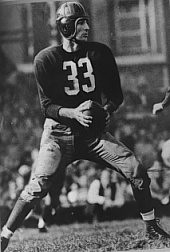Let's talk about college football for a second. The story of the year has been upsets. Top-10 teams are falling left and right, and not just to each other. Southern Cal lost to Stanford, LSU to Kentucky, Michigan to Appalachian State and everyody else. South Florida, an enormous commuter school that didn't even have a football program until a decade ago, arrived in the top 5 with much gnashing of teeth by the purists, but the Bulls didn't even have time to take a dump before losing to Rutgers.
Meanwhile, out here on the Plains, the story of the year has been the Nebraska Cornhuskers and the way their slow decline has accelerated into free-fall. In the wake of a blowout loss to Texas Tech, the university fired the athletic director (what, is the AD calling plays in Lincoln now?), and it's only a matter of time before coach Bill Callahan gets his walking papers. Former coach Tom Osborne is back as interim AD, and it's his job to make everythig right again.
Yeah, good luck with that.
The Cornhuskers aren't coming back -- not in the way Nebraskans are accustomed to, in which they contend for the national title every single year. Those days are over, just as they are for the likes of Florida State, Penn State, Notre Dame and all the other big-conference football factories that monopolized talent and exposure for decades. A team may still get on a good run for several years -- witness Ohio State and Southern Cal of late -- but it will eventually get reeled back to the pack. Why? One word: Television.
Time was, the NCAA had monopoly control over all college football on television. The NCAA decided which schools played on TV and which didn't, and what schools played on what networks. It made sure that the Big Ten and Pac-10 played on ABC, that the SEC played on CBS, that Texas, Notre Dame and the "Big 8" got a game here and there, and that everybody else -- if they were lucky -- played on local TV or on those sad little regional "networks" like Raycom and Jefferson Pilot. Why would the NCAA do something like that? Because it was controlled by the power conferences. Duh.
Eventually, in 1984, the Supreme Court called bullshit on the whole setup (thanks to a lawsuit filed by the universities of Oklahoma and Georgia), and schools and conferences were freed to negotiate their own television contracts. (The power conferences immediately tried to stuff the genie back into the bottle by banding together in the "College Football Association," but that effort fell apart after Notre Dame bolted to sign an exclusive deal with NBC.)
Before the court swept away NCAA control of TV, only power schools in power conferences got to appear on television, and that gave those schools an immense and entrenched recruiting advantage. If a high school kid got scholarship offers from both Ohio State and Kent State, there was no doubt where he'd go: Ohio State, because he'd seen them play on TV. Kent State, if he'd heard about it at all, was just that place where those soldiers shot those hippies. It's all different now. Smaller schools from the Mid-American Conference, Conference USA, the Mountain West and the Big East are on the ESPN networks every week -- every night for some stretches of the year. More kids see more schools, and are therefore willing to consider playing for more schools.
The changes in the TV system didn't reshape the college football landscape overnight, obviously. What we have today is the result of cascading effects in the two decades since the court ruling. When more schools got on television, it didn't just increase exposure for the teams; it increased exposure for the players on those teams. In 1970, if the quarterback at Miami of Ohio put up impressive numbers, he'd be a big star on campus, and maybe some NFL team would take a flier on him with an eighth-round pick in the draft. Nowadays, he's a first-round pick. With that in mind, high school players today ask themselves: Do I want to go to a huge football factory, where I'll ride the bench for at least two years, probably three, before getting a chance to compete for a starting job? Or do I want to go to a smaller school, where I'll have a chance to win the job as a sophomore -- maybe even a freshman? Coupled with restrictions on scholarships, this equality of exposure has all but killed the ability of the power schools to stockpile players. Kids today want to play more than they want to play for Nebraska or Florida or Georgia Tech or whoever. The power conferences are trying their best to unring that bell -- witness the rigged BCS system -- but they'll fail.
So that's the handwriting on the wall for Nebraska fans. Osborne could come down from the AD's suite and coach the team himself -- and coaches do retain a certain amount of recruiting pull -- but he can't turn back time. In his day, he had starting-quality players three deep on the roster. Today it's just starters and scrubs, because the kinds of kids he used to stash away as backups are now starting for East Carolina or Connecticut or Nevada on Thursday night on ESPN2.
Subscribe to:
Post Comments (Atom)


No comments:
Post a Comment